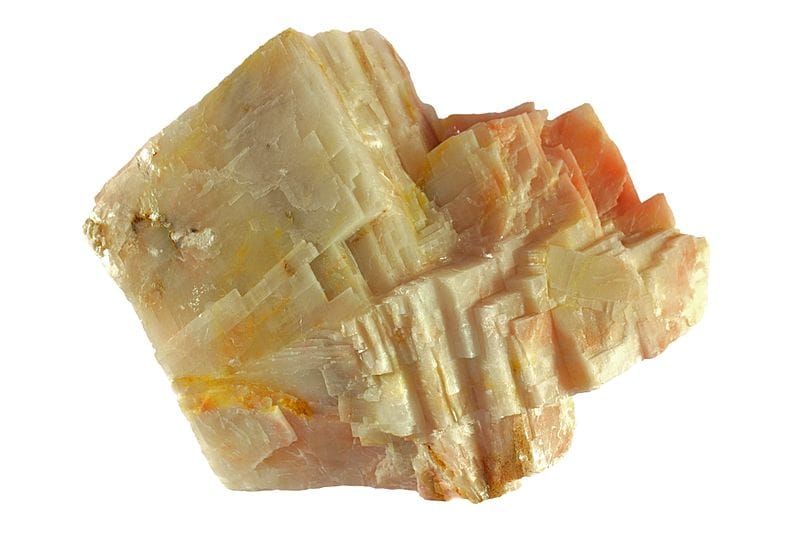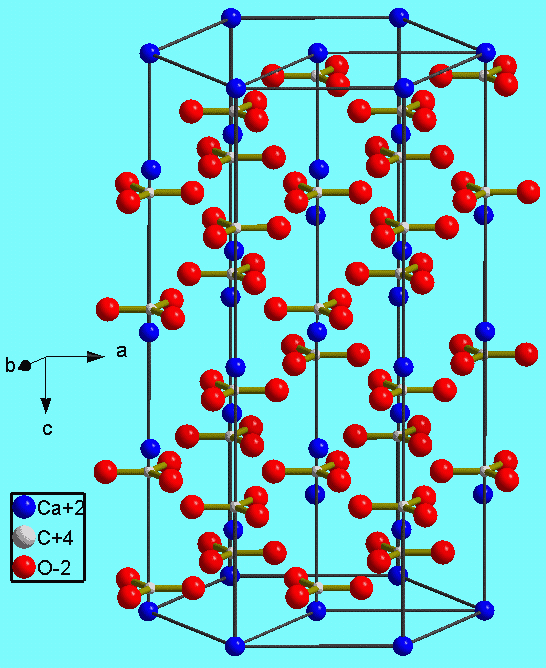
Calcite is a carbonate mineral that forms a significant part of the Earth’s crust. It’s one of the most common types of minerals and if you’ve ever been to a geological museum, the odds are you’ve seen quite a bit of it.
This mineral is predominantly composed of calcium carbonate (CaCO3). Calcite plays a pivotal role in many geological and industrial processes. But let’s take it step by step.
What is Calcite?
Calcite is the most common form of natural calcium carbonate and a key mineral in the carbonate rock group (aragonite is another type of calcium carbonate mineral). This mineral, found extensively in sedimentary rocks, especially limestones, is also a principal component of marbles, marls, travertines, and calcite veins. Its presence is not limited to rocks; it also forms a significant part of many sequences of marine sediments, reflecting its importance in both terrestrial and marine environments.
A unique feature of calcite is its polymorphism. It shares its chemical formula with other minerals such as aragonite and vaterite, but it differs in its crystal structure. In other words, these three minerals have the exact same composition, but their structure is different. While calcite is the stable form of calcium carbonate at most Earth-surface conditions, its counterparts, aragonite and vaterite, tend to form under specific, often more extreme, environmental settings.
Calcite Mineral Properties
Calcite is renowned for its diverse crystal forms, ranging from scalenohedrons to rhombohedrons, and for being part of the trigonal crystal system. One of its defining properties is birefringence, where light splits into two rays.
Physical Properties of Calcite
Physically, calcite is often colorless or white, but impurities can impart a spectrum of colors, including red, green, and blue. It scores a 3 on the Mohs hardness scale, meaning it’s relatively soft. Calcite’s specific gravity stands at 2.71, giving it a typical lightweight feel.
Chemical Properties of Calcite
Chemically, pure calcite consists mainly of CaCO3. However, it can incorporate other elements like Mg, Mn, Fe, and Sr, altering its composition. A chemical hallmark of calcite is its vigorous reaction with dilute hydrochloric acid, resulting in effervescence.
Crystal Structure of Calcite

Calcite’s crystal structure is defined by a true rhombohedral unit cell. It comprises calcium ions at the corners and CO3 groups at the center. This arrangement results in the hexagonal (trigonal) crystal system.
| Property | Description |
|---|---|
| Color | Colorless, white, or various colors due to impurities |
| Hardness | 3 (Mohs scale) |
| Specific Gravity | 2.71 |
| Chemical Composition | Primarily CaCO3 with possible elemental substitutions |
| Crystal System | Trigonal |
| Reactivity | Vigorously reacts with dilute HCl |
Calcite Occurrence
Calcite has a widespread distribution and versatile nature. It can be found in a multitude of geological settings, each highlighting a different aspect of its formation and role in the Earth’s crust.
In Sedimentary Rocks
Calcite is a dominant mineral in sedimentary rocks, especially limestones, which are formed primarily from the skeletal remains of marine organisms. Over geological time, these calcareous deposits compact and cement together, forming extensive limestone beds. Notably, limestones are not just rich in calcite; they are also significant as reservoirs for oil and gas.
As a Part of Marble
In the realm of metamorphic rocks, calcite is a primary component of marble. Marble forms through the metamorphism of limestone and other carbonate rocks. The heat and pressure of metamorphism recrystallize the calcite in the limestone, giving marble its characteristic crystalline texture and often enhancing its natural colors and patterns. In addition to calcite, marble sometimes also includes minerals like mica.
In Karst Landscapes
Karst topography, characterized by sinkholes, disappearing streams, and underground drainage systems, is a direct result of the dissolution of calcite in limestone. This soluble nature of calcite leads to the formation of these unique landscapes, where water erodes the rock, creating an array of geological features like caves, underground streams, and spectacular stalactites and stalagmites.
In Hydrothermal Veins
Calcite is frequently found in hydrothermal veins, where hot, mineral-rich waters flow through cracks in the Earth’s crust. As these waters cool, calcite and other minerals precipitate out, filling these cracks and forming veins. These veins can be sources of not only calcite but also other valuable minerals and metals.
In Hot Springs and Travertine
Hot spring environments are another common setting for calcite. As the hot, calcite-saturated water emerges and cools, calcite is deposited, forming the terraced pools and formations known as travertine. These natural terraces are not just visually stunning but also provide insights into the geochemical processes at play in these environments.

In Oceanic Settings
In the oceans, calcite plays a crucial role in the formation of coral reefs and as a component of marine sediments. Many marine organisms utilize calcite to build their shells and skeletons. Over time, as these organisms die, their calcareous remains contribute to the sedimentary deposits on the ocean floor, playing a vital role in the oceanic carbon cycle.
In Speleothems
Within cave systems, calcite is the primary mineral responsible for the formation of speleothems – the collective term for stalactites, stalagmites, and other cave formations. These structures form over centuries as dripping water, supersaturated with calcium carbonate, deposits calcite as it evaporates.
As a Weathering Product
Calcite also forms as a product of the chemical weathering of other calcium-bearing minerals. In areas with a significant amount of carbonate rocks, weathering processes can lead to the formation of calcite as a residue.
Uses of calcite
Calcite’s versatility makes it a mineral of significant economic and practical importance. Here’s an exploration of the multifaceted uses of calcite:
In Construction and Architecture
- Cement Production: Calcite, often in the form of limestone, is a primary ingredient in the manufacture of cement. When burned in a kiln and mixed with other materials, it creates the cement used in concrete and mortar.
- Building Material: Limestone, rich in calcite, is widely used as a building material. Its durability and aesthetic appeal make it a popular choice for flooring, facades, and interior decorations.
- Marble Utilization: Marble, a metamorphic rock composed largely of calcite, is prized for its beauty and is extensively used in sculpture and as an architectural material.
In Agriculture
- Soil Treatment: Calcite, in powdered form, is used to increase the pH level of acidic soils. This process, known as liming, improves soil quality, making it more suitable for agriculture by enhancing nutrient availability and microbial activity.
In Industry
- Manufacturing: Calcite is used in the manufacturing of glass, ceramics, and paint. In glass production, it acts as a flux, lowering the melting temperature of the raw materials. In paint, calcite serves as a white pigment and extender, providing bulk and improving the paint’s properties.
- Plastics and Rubber: As a filler, calcite improves the mechanical properties of plastics and rubber, contributing to their strength and stiffness.
Scientific and Optical Applications
- Optical Uses: The Iceland Spar variety of calcite, known for its birefringence, is used in optical instruments. It can split light into two polarized rays, making it valuable in polarizing microscopes and other optical devices.
- Geological Studies: Calcite is used in geological studies to understand sedimentary and metamorphic processes. Its presence and form can provide vital clues about the geological history of an area.
Environmental Applications
- Carbon Sequestration: Calcite plays a role in natural and artificial carbon sequestration processes. By binding with carbon dioxide to form calcium carbonate, calcite helps reduce the amount of CO2 in the atmosphere.
- Water Treatment: In water treatment processes, calcite is used to neutralize acidic water and remove impurities, making it safe for consumption and use.
Art and Jewelry
- Decorative Stone: Owing to its variety of colors and forms, calcite is used as a decorative stone in jewelry and ornamental objects. Its unique crystal shapes and color variations appeal to collectors and artisans.
Ultimately, calcite is one of the most impactful minerals on the surface of the Earth. Any geology aficcionado should be aware of the basics of calcite and understand how this mineral forms and interacts with other chemical substances.






